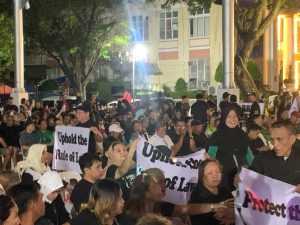AN ENVIRONMENTAL group here raised the alarm on the development of Elize Point due to the proposed location’s environmental risks if construction pushes through.
On Wednesday, Interfacing Development Interventions for Sustainability (IDIS) pointed to the Landslide Susceptibility Maps of the Mines and Geosciences Bureau XI, which identified certain areas of the site as highly susceptible to landslides.
“The development site falls under the Low-Density Residential (R1) and Low-Density Commercial (C1) Zones, such particular areas adjacent to GSIS Heights and Royal Pines, which are existing Low Residential Zones,” Lemuel Manalo, IDIS program coordinator said.
Areas identified as landslide-susceptible contain steep slopes with soil composition high in porous limestone prone to rock falls, debris flow, and sinkhole formation.
Elize Point, a new residential development project by One Davao Township Corp., a subsidiary of Discovery World Corporation (DWC), spans 11 hectares along Shrine Hills in Matina, Davao City.
On June 18, Elize Point posted on Facebook that the company held a groundbreaking ceremony on June 17, to mark the commencement of development activities.
It broke ground on a 4-hectare area covered by a Development Permit issued on Jan. 31, 2023.
To recall, the Sustainable Davao Movement (Formerly Save Davao Shrine Hills Advocates and Green Davao Coalition) has long advocated for the restriction of developments in Shrine Hills due to its disaster risks of erosion and landslides.
The 222 hectares of Shrine Hills were then declared in 2013 as an Urban Ecological Enhancement Sub-Zone (UEESZ) in Davao City’s Comprehensive Land Use Plan and Zoning Ordinance for 2011-2022, providing strict restrictions for land development.
Manalo said if one possesses a lot identified under UEESZ, only 30% is allowed for development while 70% is for green spaces. Meanwhile, for areas with high susceptibility to landslides, the City Building Official will not issue Building permits.
Out of 11 hectares to be developed by Elize Point, Manalo said that 52% of the site is highly susceptible to landslides, as it is situated next to Matina GSIS Heights, which is on the steepest slope.
Loophole
Manalo said the local Zoning Ordinance 2018-2028 has failed to identify the development site as under UEESZ when its land composition and geological characteristics are similar to that of Shrine Hills.
In 2013, the Zoning ordinance identified Sto. Nino Shrine, which is the property site of Elize Point, was under the Tourism Development Zone. Outside Sto Nino Shrine is where the development site is.
However, in the 2018 zoning map, Manalo said the city council should have delineated it under UEESZ even its susceptible to landslides but continued the zoning to Low-Density Residential.
“The restrictions of the UEESZ do not apply to their site anymore so when the city planning checks, they will approve and release the locational permit because it doesn’t fall in the UEESZ,” he said.
Manalo added this resulted in Elize Point being permitted to sell units by DHSUD as it falls to the right zoning as per the city government.
At present, Elize Point has 26 lots available in the market as covered by DHSUD License to Sell No. 0000939 issued on March 10, 2023.
The plea
IDIS recommends that High susceptibility to Landslide areas within Elize Point project sites should be classified as “No Build Zones” as per Sec. 1 C. Other Regulations of Ordinance No. 0861-22 Series of 2022 on the regulations of UEESZ stated that “No residential building will be constructed within high risk to landslide area.”
Additionally, IDIS called the city government to review the current zoning ordinance (2018-2028) to delineate the other areas identified with high susceptibility to disasters to be designated as UEESZ or other disaster and environmental mitigating zones.
They also called on Elize Point and One Davao Township Corp. to adopt Low Impact Development (LID) and nature-based solutions in all of their structures.
“We can’t do anything with areas under Low-Density Residential (R1) and Low-Density Commercial (C1) Zones because it is in the right zone, especially in the flat area of the property but still they have to adapt Low Impact Development,” Manalo said.
He added Elize Point can also look into highly landslide-susceptible areas and 90-100 degrees slopes to be allocated as green spaces rather than developing a building.
“They own the property, they can develop it, there’s no problem as long as it is suitable for intended construction, however areas for development constraints should be “no build zone” because of the hazards,” Manalo said.



